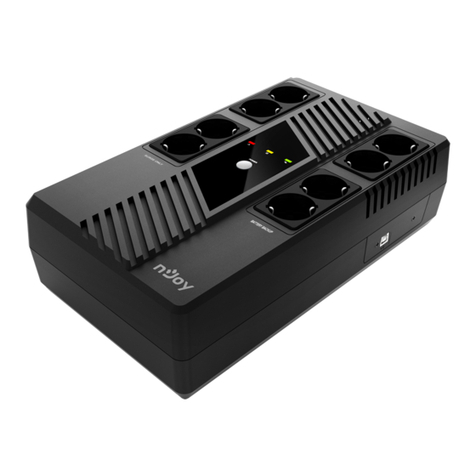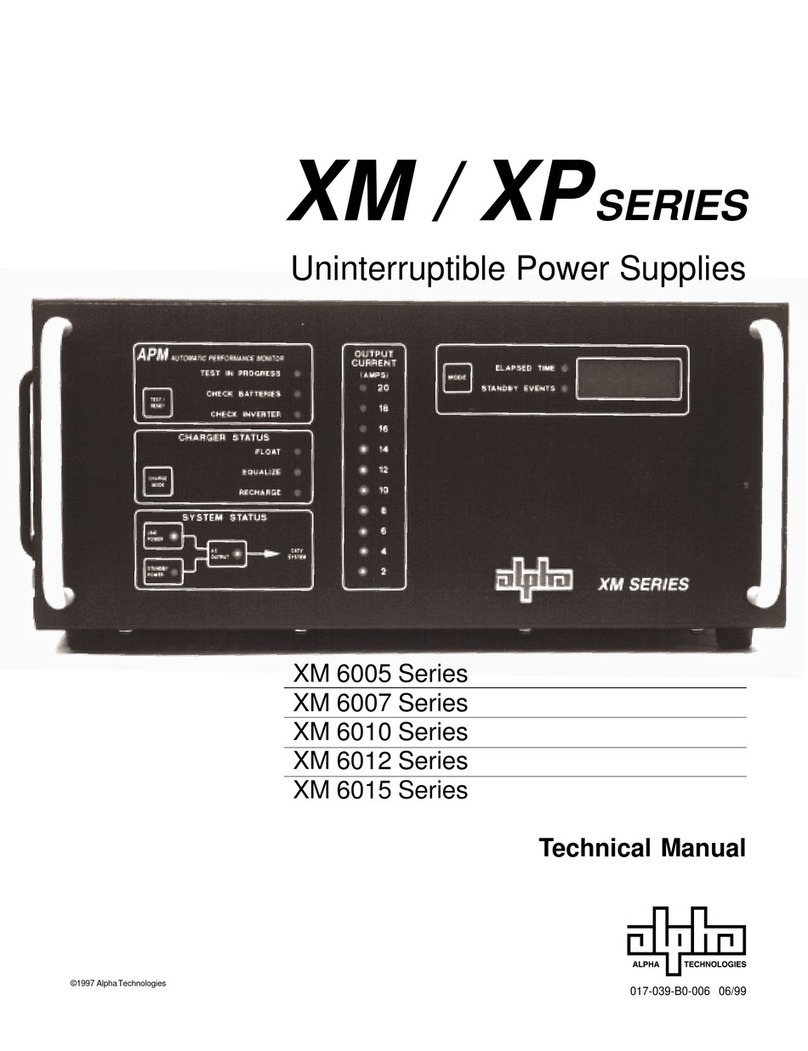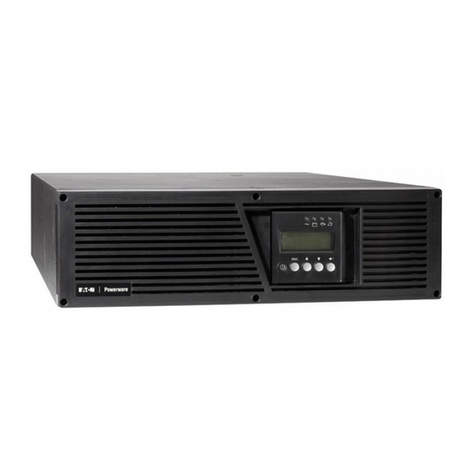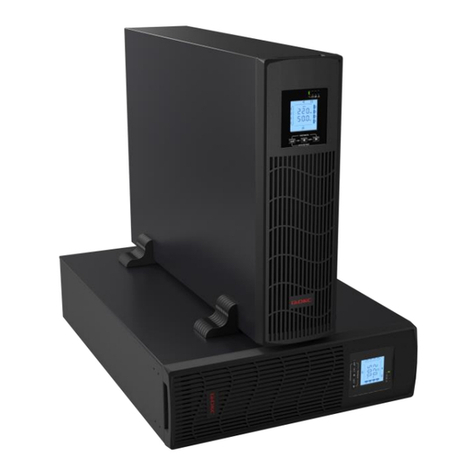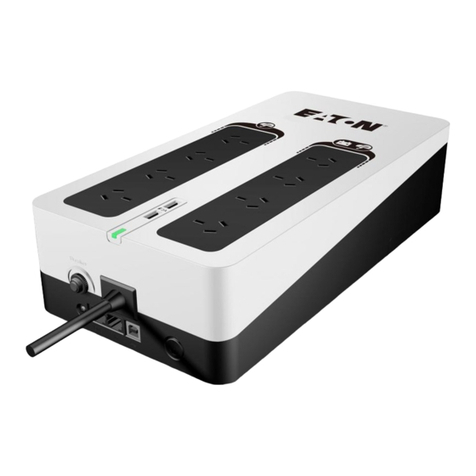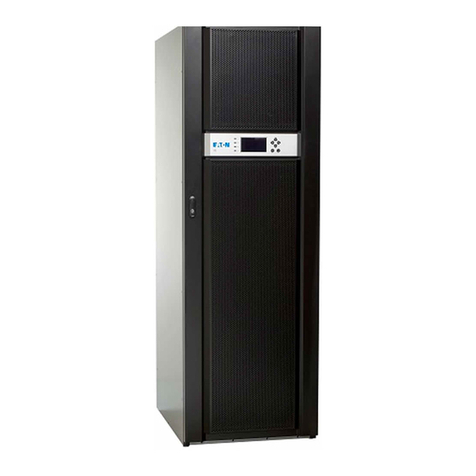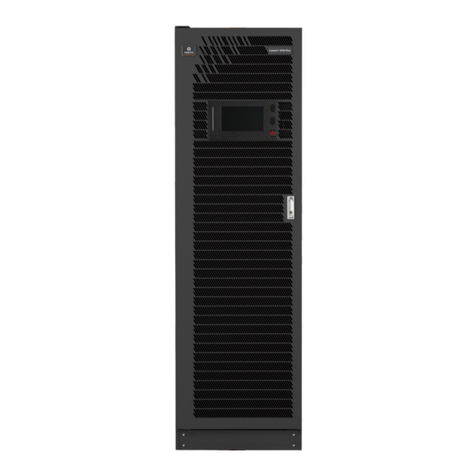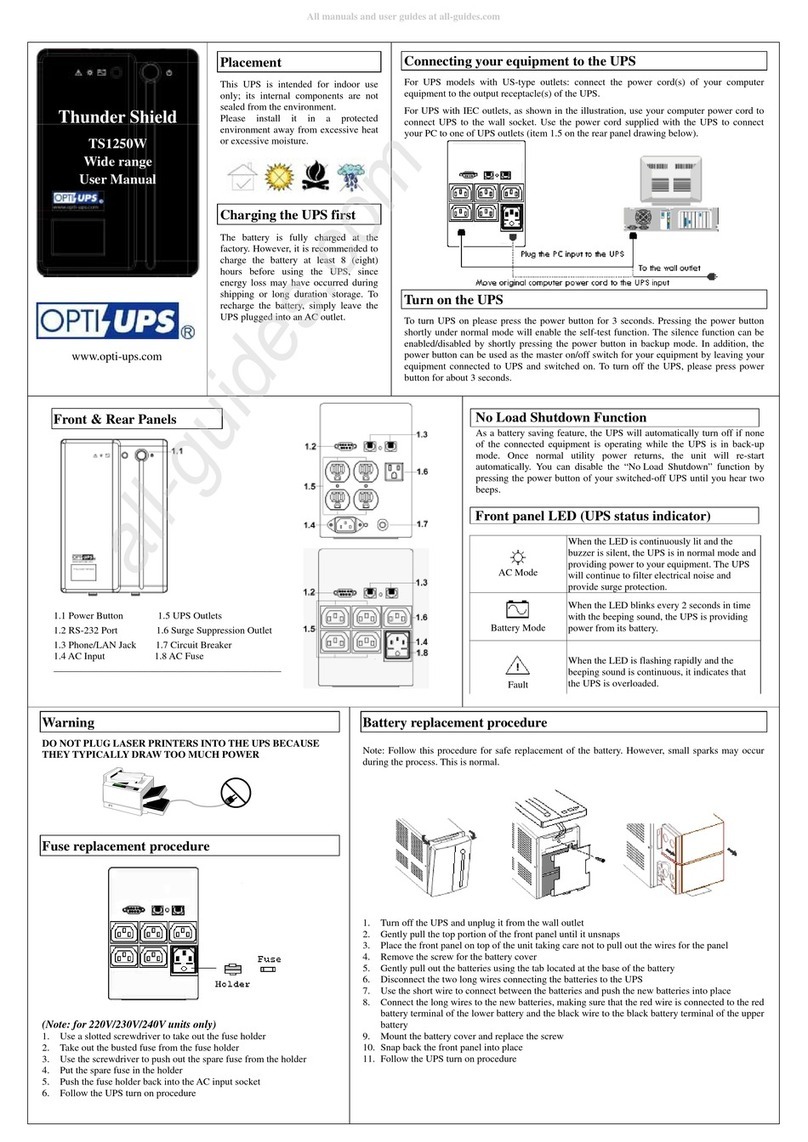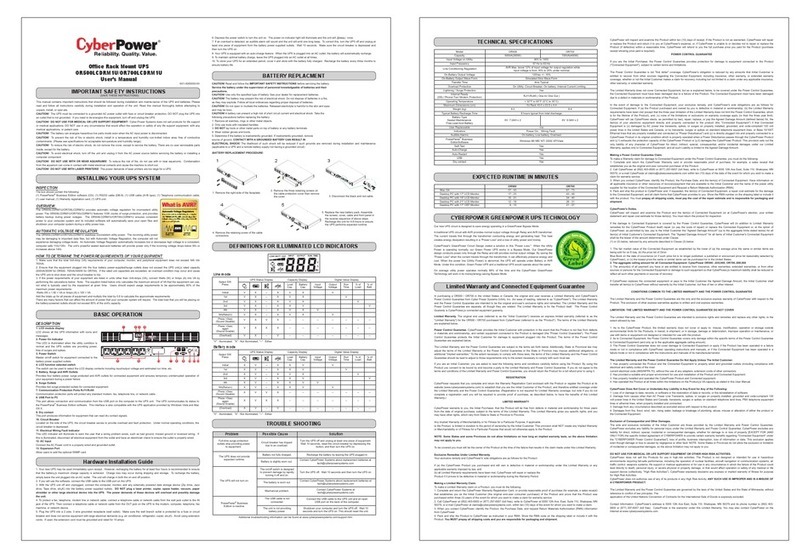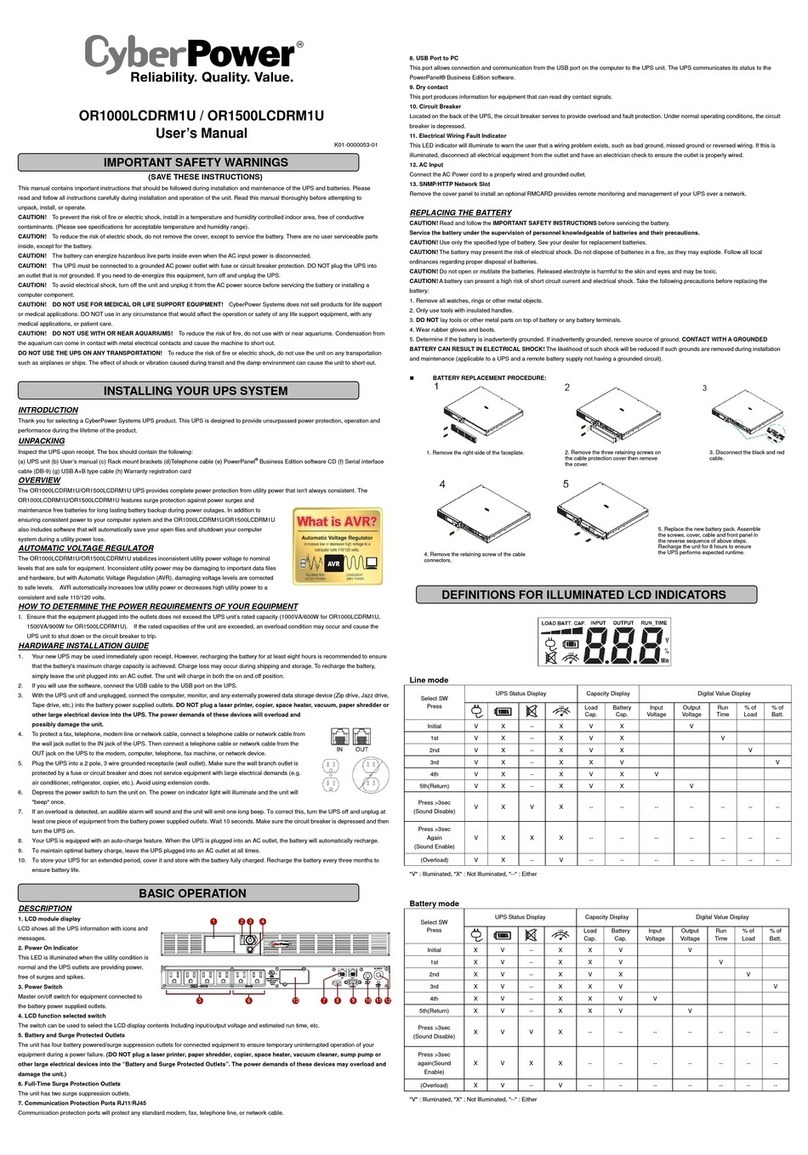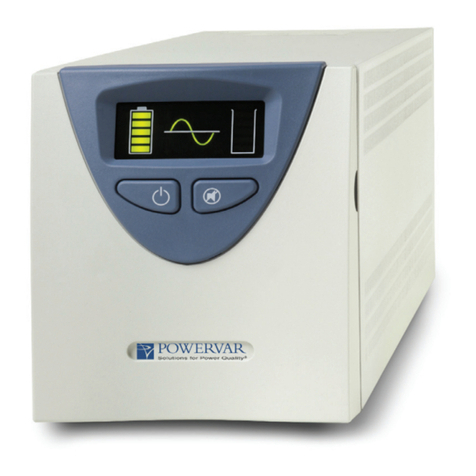Smart power Smart Sine Pro Series User manual

USER'S GUIDE
Uninterruptible Power Supply
SMART SINE PRO SERIES
SSP Series
Line Interactive
Pure Sinewave UPS
750VA, 1000VA, 1500VA, 2000VA, 3000VA
750VA - 1000VA 1500VA - 2000VA
3000VA

IMPORTANT SAFETY INSTRUCTIONS
SAVE THESE INSTRUCTIONS This manual contains important
instructions for 750/1000VA, 1500/2000VA, 3000VA series that
should be followed during installation and maintenance of the
UPS and batteries. Please read all safety and operating
instructions before operating the UPS. Adhere to all warnings on
the unit and in this manual. And follow all operating and user
instructions.

CONTENTS
1. INTRODUCTION 1
2. SAFETY INSTRUCTION CAUTION 2-4
3. SYSTEM DESCRIPTION 5-15
4. INSTALLATION 16-27
5.ADDITIONAL BATTERY INSTALLATION SETUP 28-29
6. BATTERY REPLACEMENT 30-35
7. COMMUNICATION PORT 35
8. TROUBLESHOOTING 36-37
9. SPECIFICATION 38-39
10. SOFTWARE INSTALLATION 40

1
1. INTRODUCTION
Features:
Microprocessor control guarantees high reliability
High frequency design
Built-in boost and buck AVR
User replaceable design for 1500VA or above
Selectable output range and line sensitive
Cold startup capability
Built-in Dry contact/RS-232/USB communication port
SNMP allows for web-based remote or monitoring management
Enable to extend runtime with scalable external battery pack for
1500VA or above
Overload, Short-circuit, and overheat protection
Rack/Tower 2 in 1 Design
n
n
n
n
n
n
n
n
n
n
n
n19” rack mount available for all models
This UPS is a compact and line interactive pure sinewave device designed for
critical applications and environments, such as desktops, servers,
workstations, and other networking equipment. This model is available in the
output ratings of 750, 1000, 1500, 2000, and 3000VA. This UPS Series
protects your sensitive electronic equipment against power problems
including power sags, spike, brownouts, line noise, and blackouts.
This series is designed as a two-in-one form factor to be placed either in a
Rack (2U) or as Tower. The front panel of the UPS includes LED indicators
and four push buttons (Power Switch, UPS Test/Silence, Configure, and
Enter) that allow for easy configuration and monitoring AC line-in, notification
of site wiring fault and output load status of the UPS. It also includes four LED
bar graph (Load/Battery Level Indication); two status indications (On AC, On
Battery); five alarm indications (Overload, Over Temperature, Site Wiring
Fault, Battery Fault, Self Test Failure). A push button from the front panel
allows silencing of the AC fail alarm and the initiation of the UPS self test
sequence as well. The UPS case for 750 ~ 2000VA is made of plastic and the
3000VAis made of metal.
This series is powered from the AC mains and supply AC outputs via
receptacles on the rear panel. Communication and control to the unit is
available through serial or USB ports located on the rear panel. The serial
port will support communications directly with a server. The communications
protocol for the serial ports shall conform to true RS232 interface.

2
2. SAFETY INSTRUCTION CAUTION
WARNING: Do not attempt to repair and service this UPS. This UPS
contains high voltages that may cause the risk of electrical shock.
Even if this UPS is disconnected from the electrical outlet, the
dangerous voltage still may be present through the battery. All
maintenance and battery replacement should be performed by
qualified service personnel only.
1. This UPS should be placed indoors with adequate airflow and free of
contamination. To install or operate it in a clean and indoor
environment, free from moisture, flammable liquids, and direct sunlight.
Ambient temperature range must be 0°C to 40°C (32°F to 104°F).
2. This UPS is designed for Commercial/Industrial use only. It is not
intended for use with life support application and other designated “life-
critical” devices.
3. Do not remove the input power cord when this UPS is turned on. This
removes the safety ground from this UPS and the equipment connected
to the UPS.
4. Turn off this UPS and disconnect input power cord before replacing
battery.
5. Battery contains high short-circuit current. Replacing or servicing the
battery should be performed and supervised by qualified service
personnel knowledgeable of batteries and required precautions.
Remove watches and jewelry
Use tools with insulated handles
6. When replacing the batteries, use the appropriate replacement battery kits,
same number and type of battery are a MUST.
7. Do not open or mutilate the battery. Released electrolyte is harmful to skin
and eyes that may be toxic.
8. Do not dispose of battery in a fire. Battery may explode. Proper disposal of
battery is required. Please refer to your local laws and regulations for
disposal requirements.
n
n

3
2. SAFETY INSTRUCTION CAUTION
9. The total equipment connected to the output of this UPS must not have
an earth leakage current exceeding 3.5 milliamperes. If the connected
load earth leakage current is over 2.5 milliamperes, please convert the
input lead attachment to either a fixed wiring installation or an industrial
plug/socket (e.g. CEE 17 connector). This task should be carried out by
a qualified electrical engineer who is conversant with local electrical/
regulations.
10. This UPS contains high voltages that may cause the risk of electric
shock. Do not remove cover. There are no user replaceable parts
inside this UPS. Please contact your local dealer or distributor for
service.
11. To reduce the risk of fire, connect to a circuit provided with 1.25 (at
least 20A) amperes maximum branch circuit over-current protection in
accordance with the National Electric Code, ANSI/NFPA.
12. This pluggable type A equipment with battery already installed by the
supplier is operator installable and may be operated by laymen.
13. During the installation of this equipment it should be assured that the sum
of the leakage currents of the UPS and the connected loads does not
exceed 3.5mA.
14. Attention, hazardous through electric shock. Also, with disconnection of
this unit from the mains, hazardous voltage still may be accessible
through supply from battery. The battery supply should be therefore
disconnected in the plus and minus pole of the battery when
maintenance or service work inside the UPS is necessary.
15. The mains socket outlet that supplies the UPS shall be installed near the
UPS and shall be easily accessible.

4
2.SAFETY INSTRUCTION CAUTION
2.1 Description of Commonly Used Symbols
Description
Alert you to pay special attention
Caution of high voltage
Alternating current source (AC)
Direct current source (DC)
Protective ground
Recycle
Keep UPS in a clear area
Symbol
Symbol & Description

5
No. Function Description
1 Switch ON/OFF
2 Switch Self-Test/ Alarm Silence
3 Switch Config
4 Switch Enter
5 LED Input Type(Operating Mode)
6 LED Voltage Range
7 LED Bad Battery
8 LED Overload
9LED Fault
10 LED PSDR Fail (or Site Fault)
11 LED Battery Mode
12 LED Line Mode
13 LED Capacity of Load
14 LED Capacity of Battery
3.SYSTEM DESCRIPTION
Front Panel

6
1. Power Switch:
2. UPS Test/ Alarm Silence:
. Configure:
Step 1:
Step2:
Step3:
Step4:
Step5:
Step6
4. Enter:
- To turn on the UPS, press the button more than three seconds
- To turn off the UPS, press and hold this button until you hear the UPS beep
ceases.
- The battery is fully charged during in-line mode. To perform self-test
function, press and hold the button for five seconds.
To reconfigure the internal UPS setup options, follow the procedure as below:
Press the Configure button more than three seconds. Then UPS
will transfer from configure mode to “output voltage mode”.
Press the Configure button more than one second, the UPS
allows you to select the “output voltage mode” one by one.
After selecting the mode, press the Enter button more than three
seconds, the “output voltage mode” is configured.
UPS will automatically transfer from configure mode to “operating
mode”.
Press the Configure button more than one second; the UPS will
allow you to select the “operating mode” one by one.
: After selecting the mode, press the button more than three
seconds, the “operating mode” is configured.
Press the button after you choose the mode.
Note: Unable to disable alarm buzzer as below conditions: Low Battery,
Overload, Fan Failed, Fan Fault Time Out, Over Temperature.
3
- To disable alarm buzzer, press this button for a second. Each time a new
alarm event is encountered the alarm will sound. Press this button to turn
off each new alarm.
3. SYSTEM DESCRIPTION

7
3. SYSTEM DESCRIPTION
1. Input Type (Operating Mode) LED:
2. Voltage Range (Output Voltage Mode) LED:
l
l
l
Normal mode: The Yellow LED indicator will illuminate during normal
mode, the UPS accepts AC input voltage range from +/-20%.
Generator: No change to voltage window. However, the low frequency
transfer point is changed to 40Hz and there is no limitation for high frequency
transfer point.
Wide range: The LED indicator will illuminate, the UPS accepts AC input
voltage range from -30% ~ +20%.
UPS Output voltages selection: 110VAC/120VAC/127VAC or
220VAC/230VAC/240VAC.
7. Bad Battery LED:
8. Overload LED:
9. Fault LED:
The LED indicator will flash every two seconds when the battery has failed, or
if the battery is disconnected. Please check your battery connection; replace
the battery or contact your local dealer for a battery replacement kit.
The LED indicator will light when the UPS is overloaded.
The LED indicator will light when the UPS fails/overload or battery
timeout/no output.
INPUT TYPE
NORMAL
GENERATOR
WIDE RANGE
VOLTAGE RANGE: VOLTAGE RANGE:
110VAC 220VAC
120VAC 230VAC
127VAC 240VAC

8
PSDR FAIL LED: the LED indicator will light when the power module of
UPS fails.
SITE FAULT LED: the LED indicator will light on when UPS is plugged into
an improperly utility
The LED indicator will flash every five seconds when the UPS is providing
battery power to your equipment. On the other hand, the LED indicator gives
you a warning which will flash every two seconds when the battery is low.
The line LED indicator illuminates when the AC source is present.
The LED indicator and the load level indicator will
illuminate to show the load level.
There are four LED bar graph to indicate the percentage of UPS load
capacity which is being used by the protected equipment. The greater the load,
the more LED indicators that will be illuminated. Each LED indicator
designates a 25% of the UPS output capacity. Please see the following load
level respectively.
0 ~ 25%: 1 LED indicator
26% ~ 50%: 1 and 2 LEDs indicator
51% ~ 75% : 1 , 2 , and 3 LEDs indicator
76% ~ 100%: All of four LED indicators will illuminate
: The LED indicator and battery level indicator will
illuminate to show battery level.
10.PSDR FAIL LED (or SITE FAULT LED):
11. BAT Mode LED (Battery Mode):
12. Line Mode LED:
13. Capacity of Load LED:
Load Indicator:
Load Level Indicator:
14. Capacity of Battery LED:
Battery Indicator
l
l
l
l
u
u
u
u
Note: “SITE FAULT” function is only available for 120Vac models.
st
st nd
st nd rd
3. SYSTEM DESCRIPTION
25% 50% 75% 100%

9
25%50%75%100%
0 ~ 25%: 4 LED indicator
26% ~ 50%: 3 and 4 LEDs indicator
51% ~ 75% 2 , 3 , and 4 LEDs indicator
76% ~ 100%: All of four LED indicators will illuminate
u
u
u
u
th
rd th
nd rd th
Indicator Condition -
3. SYSTEM DESCRIPTION
lBattery Level Indicator:
There are four LED bar graphic to indicate the amount of battery capacity
remaining. The higher the battery capacity, the more LED indicators that will
be illuminated. Each LED indicator designates a 25% capacity level. Please
see the following capacity level respectively.
Condition Alarm
Utility Mode
(AC Mode)
Line LED Lighting
Backup Mode
(Power Failure)
Flashing every four seconds
Site fault LED lighting (For 120VAC Models)Site Fault
4 segment LED bar:
0~25%: 4th LED lighting; 26~50%: 3rd and 4th
LEDs lighting; 51~75%: 2nd,3
rd, and 4th LEDs
lighting; 76~100%: all of 4 LEDs lighting
UPS Fault Fault LED lighting
Overload Overload LED lighting
Low Battery Battery LED flashing every second
Audible Alarm Condition
Condition Alarm
Backup Mode
(Power Failure)
Sounding every four seconds
Low Battery Sounding every second
UPS Fault Continuously Sounding
Overload Sounding every second
Battery Replacement Sounding every second

10
Back Panel -
3. SYSTEM DESCRIPTION
750/1000VA
Rear panel description for LV and HV models table
Function
No. LV model (110/120/127Vac) HV model (220/230/240Vac)
1Modem/Network Surge Protection
2RS232 / Dry-Contact Communication Port
3USB Communication Port
4AC Input Power cord AC Input & Protection
5AC Output NEMA AC Output IEC

11
1.Host Rear Panel:
The host rear panel pictures for HV and LV models are shown as below:
3. SYSTEM DESCRIPTION
1500/2000VA
Host Rear panel for HV model
Host Rear panel for LV model

12
Rear panel description for LV and HV models table
3. SYSTEM DESCRIPTION
Function
No. LV model (110/120/127Vac) HV model (220/230/240Vac)
1 RS232 / Dry-Contact Communication Port
2SNMPPort
3 USB Port
4 EPO
5 Modem/Network Surge Protection
6 N/A Input Breaker
7 AC Output
8 AC Input AC Input
9 External Battery Connector
2. EBM Rear Panel:
The EBM rear panel pictures for HV and LV models are shown as below:

13
3. SYSTEM DESCRIPTION
EBM Rear panel for LV model
Rear panel description for LV and HV models table
Function
No. LV model (110/120/127Vac) HV model (220/230/240Vac)
1 Battery Output Power Cord
2 AC Output
3 External Battery Connector
4 Output Breaker N/A
5 Output Breaker N/A
6 Output Receptacles Output Receptacles

14
3. SYSTEM DESCRIPTION
3000VA
Rear panel for HV model
Rear panel for LV model

3. SYSTEM DESCRIPTION
Rear panel description for LV and HV models table
Function
No. LV model (110/120/127Vac) HV model (220/230/240Vac)
1 Output Breaker
2 AC Output
3 AC Input
4Modem/Network Surge
Protection
Modem/Network Surge
Protection
5 Input Breaker N/A
6 Input Power Cord N/A
7 SNMPSlot SNMPSlot
8 External Battery Connector External Battery Connector
9 EPO EPO
10 USB Port USB Port
11 RS232 / Dry-Contact Communication Port
15

16
1. Inspecting the Equipment
2. Placement
3. Charging
4. Load Connection
5. Modem/Phone line Connection
6. DC Start Function
Inspect the UPS upon receipt. If the UPS has been damaged during
shipment, keep the box and packing material for the carrier. Notify the
carrier and dealer immediately.
This UPS should be installed indoors with adequate airflow and free
of contamination. Locate it in a clean and indoor environment, free
from moisture, flammable liquids, and direct sunlight. Maintain a
minimum clearance of 4 inches (100mm); an ambient temperature
range must be 0°C to 40°C (32°F to 104°F), and operating humidity
range must be 20% to 80% relative humidity (non-condensing).
This UPS is shipped from the factory with its internal battery fully
charged; however, some charge may be lost during shipping. The
battery should be recharged prior to use. Plug the UPS into an
appropriate power supply and allow the UPS to charge at least 4
hours.
Connect one load-related device to each of the power receptacles
supplied at the rear of the UPS.
Plug incoming telephone line into the “In” socket at the back of the
UPS. Use on telephone line cable and plug one end of the telephone
line cable to the “Out” socket at the back of the UPS. Plug the other
end to the modem input socket.
DC Start Function enables UPS to be started up when AC utility
power is not available and battery is full charged. Just simply press
the On/Off switch to turn on the UPS.
CAUTION: The long term use at ambient temperature higher than
25C should reduce battery life. In addition, place the UPS
unit away from the monitor at least 8in.to avoid
interference.
4. INSTALLATION

17
7. Turn On/Off
8.UPS Setup
9. Tower Setup
750/1000VA
Tower form
To turn on/off the UPS, you should press the on/off switch three seconds at
least.
All models series are designed for tower and rack purpose. They can be
installed as a 19 inch equipment rack, and 3000VA can be placed in a tower
(with optional stand) as well. Please follow the instruction for Tower Setup or
Rack-Mount Setup.
This series can be placed in horizontally and vertically. 3000VA model is
designed in a rack itself. As a tower, it is provided with the optional UPS stand
to stabilize the UPS when the UPS is positioned in vertically. The UPS stand
must be attached to the bottom of the tower.
l
4. INSTALLATION
110VAC
120VAC
127VAC
ON / OFF TEST CNFG ENTER
INPUT TYPE:
WIDE RANGE
GENERATOR
NORMAL
VOLTAGE RANGE:
110V 120V 127V
100%
100%
OVERLOAD
BAD BAT.
FAULT
PSDR FAIL
75%
75% 50%
50%
25%
25%
+
-
This manual suits for next models
1
Table of contents
Other Smart power UPS manuals
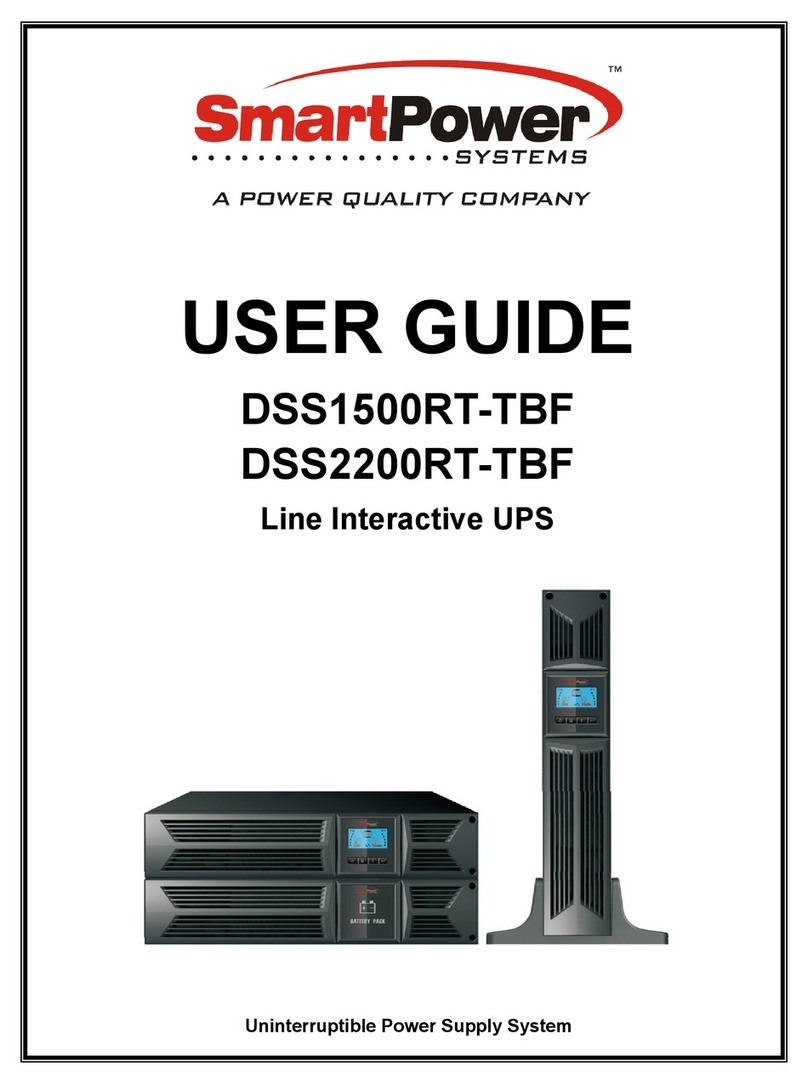
Smart power
Smart power DSS1500RT-TBF User manual
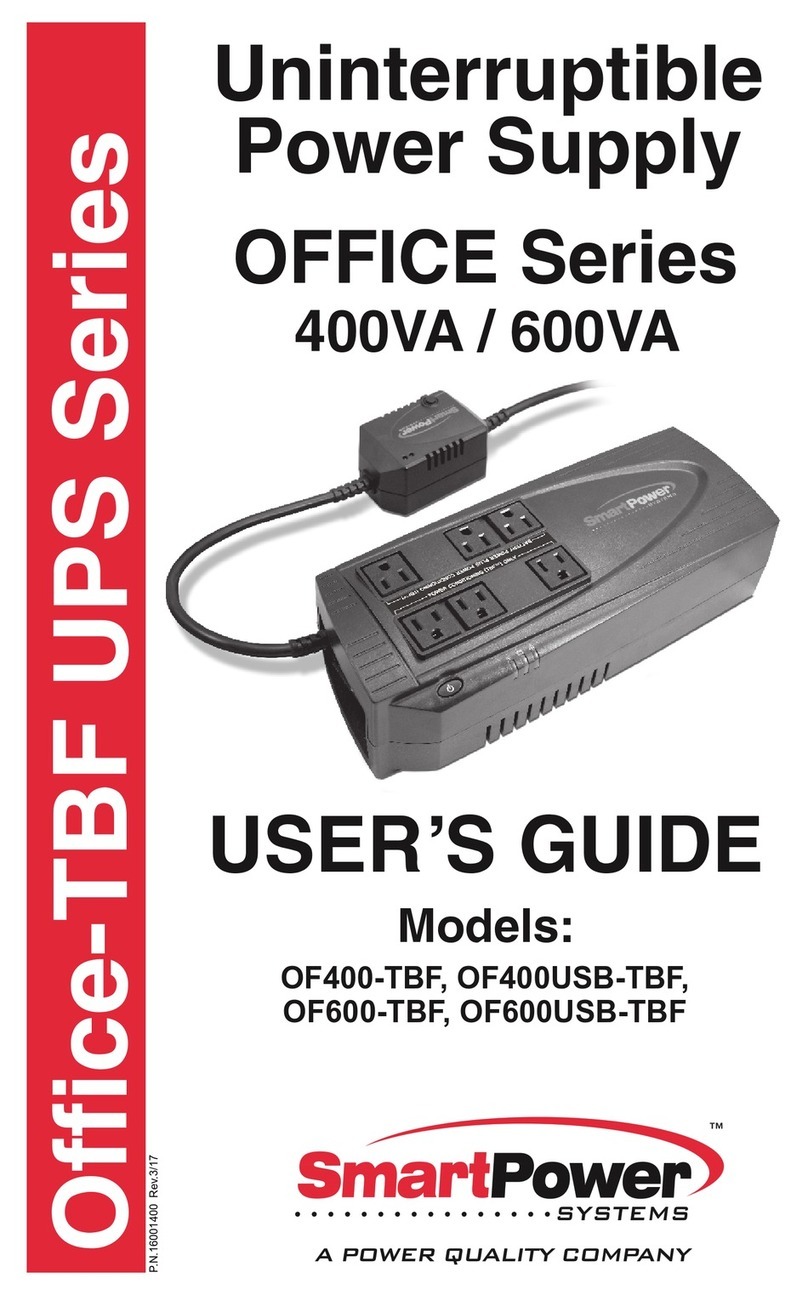
Smart power
Smart power OF400USB-TBF User manual

Smart power
Smart power SBP Plus Series User manual
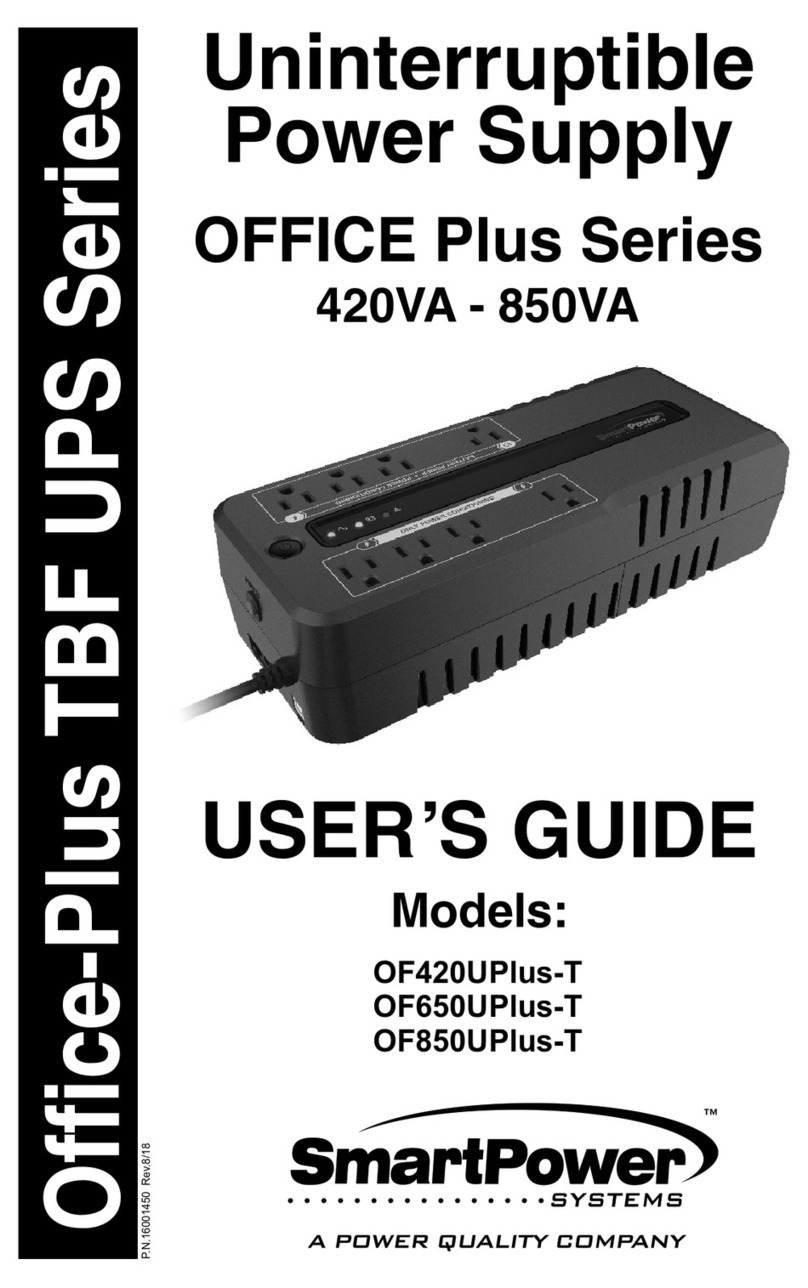
Smart power
Smart power OFFICE Plus Series User manual
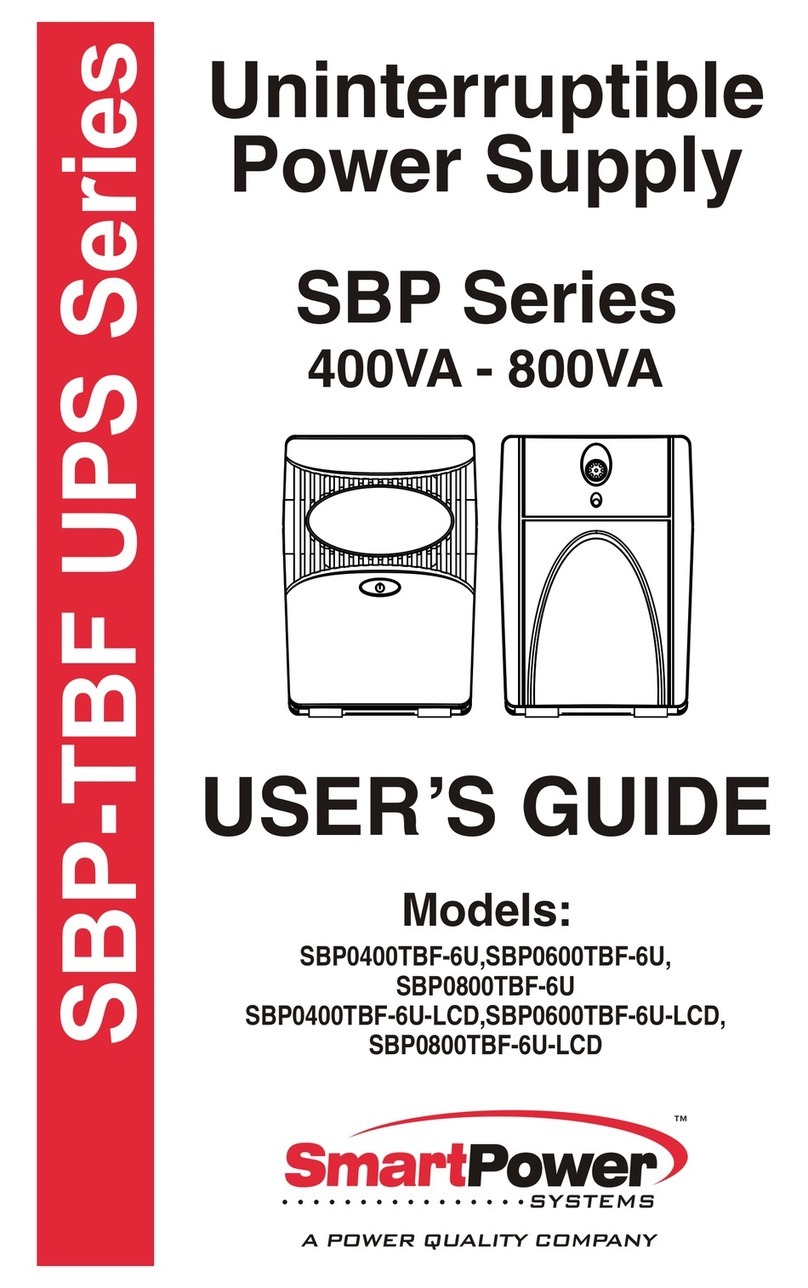
Smart power
Smart power SBP0400TBF-6U User manual
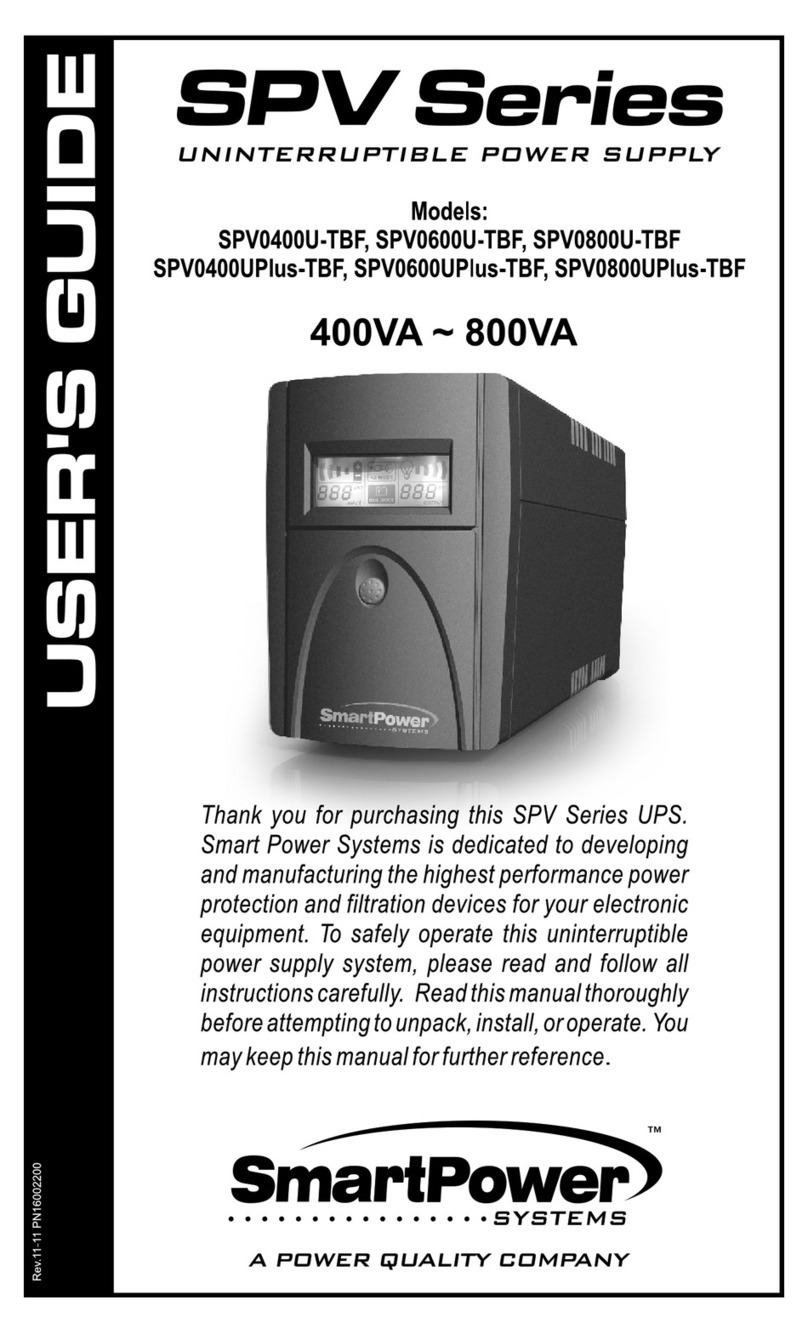
Smart power
Smart power SPV0400U-TBF User manual
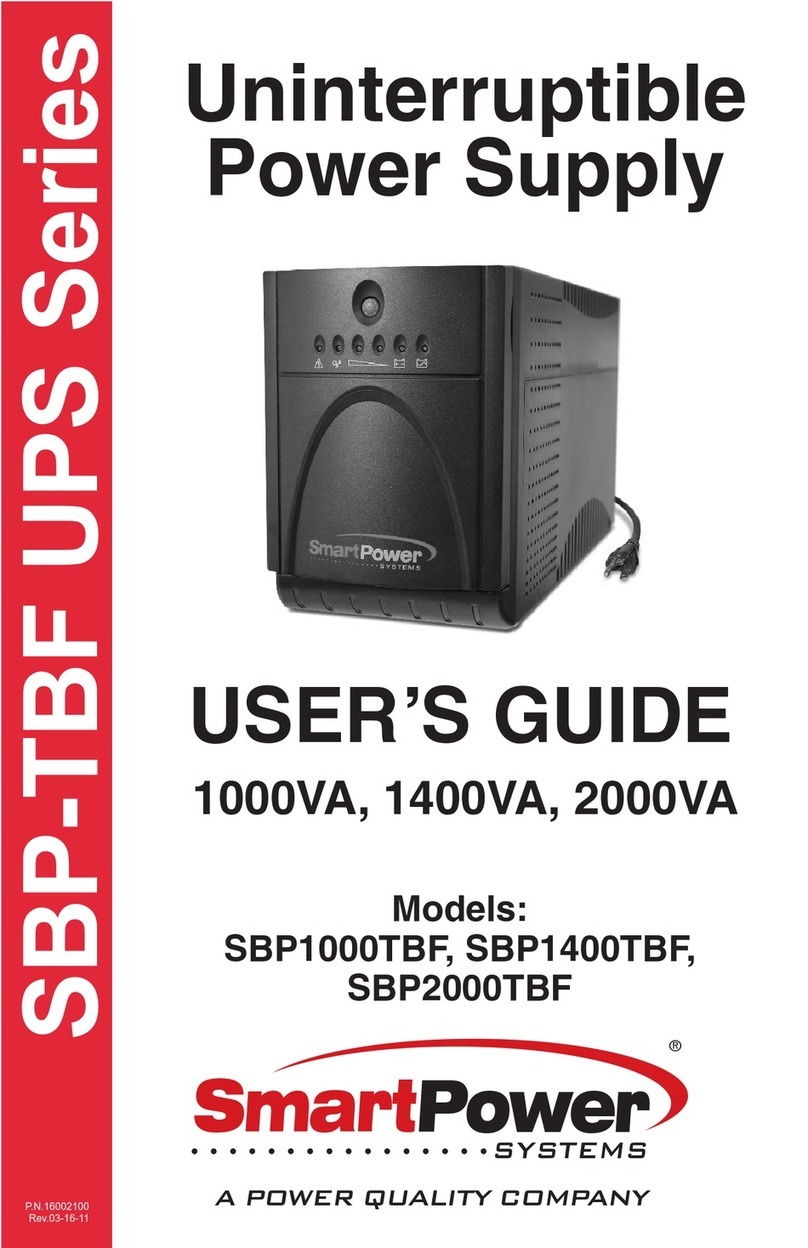
Smart power
Smart power SBP1000TBF User manual
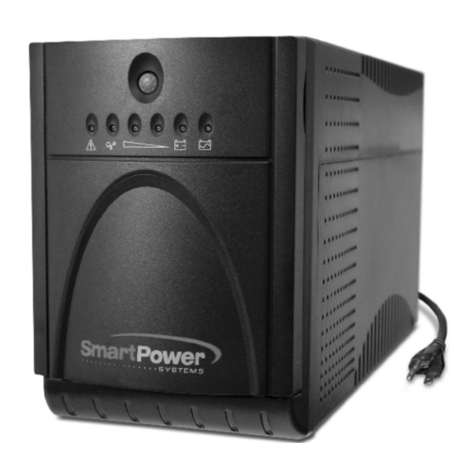
Smart power
Smart power SBP-TBF Series User manual

Smart power
Smart power Venus Series User manual

Smart power
Smart power 2L User manual
